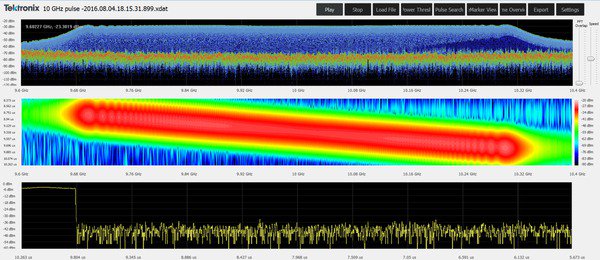
Contactez-nous
Chat en direct avec un représentant Tek. Service disponible de 9 h à 17 h, CET jours ouvrables.
Appelez-nous au
Disponible de 9 h à 17 h CET jours ouvrables.
Télécharger
Télécharger des manuels, des fiches techniques, des logiciels, etc. :
Feedback
DataVu-PC
Software
Plus d’informations
- DataVu-PC
- Assistance produit
- Découvrez d'autres modèles Analyseur de spectre : comment choisir son modèle ?
Lire en ligne :

DataVu-PC makes short work of recording and searching through large datasets for signals of interest. You can measure, control, and record with two USB instruments simultaneously, then search for and measure pulses and other signals, minimizing time spent in post-capture analysis.
Features & Benefits
- Enables easy recording for all Tektronix USB instruments, supporting up to 2 units operating simultaneously at independent frequencies and spans, recording at bandwidths from 9.7 kHz to 40 MHz
- Instruments can be controlled, and spectrums displayed, at spans up to the maximum of the instrument frequency range for fast signal discovery over broad frequency ranges
- Frequency-mask search finds events based on user-defined spectral profiles
- Pulse analysis calculates start/stop time, average/peak power, pulse duration, Pulse Repetition Interval (PRI) and start/stop frequencies on up to 2,000,000 pulses
- Pulse analysis results can be saved in Pulse Descriptor Word (PDW) format for use with other tools
- File progress bar gives analysis position at a glance, with visual display of marker events
- Provides analysis for all recording solutions (RSA300/500/600/5000/7100 series), minimizing time spent learning new tools
- Color-graded spectrum density display visualizes infrequent signal occurrences, reducing analysis time
- Color-graded spectrogram display shows time and frequency relationships
- Power vs. time display provides streaming zero-span display for detailed pulse analysis
- FFT overlap and speed controls optimize between highest probability of intercept vs. analysis time
- User settable sliders for start/stop point saves time in re-examination of signals of interest
- Export areas of interest to .XDAT, .SIQ or .TIQ formats for further analysis
- eMarkers provide search, mark and save on up to 2,000,000 user-defined amplitude events
- Analyzes files in .XDAT format from any source, including third-party recording solutions
Applications
- Spectrum management
- Interference hunting
- Pulsed signal analysis
- SIGINT data collection
- EW testing
- RF system design
DataVu-PC analysis saves you time and helps you succeed
When combined with the signal recording capabilities of all Tektronix spectrum analyzers, DataVu-PC can turn hours of attended monitoring into fast post-acquisition search, mark and measurement tasks. You can search based on signal amplitude and frequency characteristics, marking each occurrence of an event for later examination. Pulse measurements can be made with the pulse application on up to 2,000,000 pulses and PDWs can be exported in tab-delimited format with headers for integration into other workflows.
Should you need to perform in-depth modulation, pulse or standards-based analysis, DataVu-PC can convert recordings to the SignalVu-PC file format (.TIQ), and can convert recordings made with Tektronix USB-based spectrum analyzers and SignalVu-PC from .R3F format into formats compatible with DataVu-PC.
Three bandwidth options are available to make DataVu-PC an affordable tool to analyze large files from all Tektronix recording spectrum analyzers.
DataVu-PC offers highly flexible, 2-channel recording with USB spectrum analyzers
DataVu-PC offers recording using two RSAs so that you can operate at two independent frequencies and spans simultaneously. One instrument can be used for wide-span signal detection and a second instrument can be used for isolation on signals of interest and recording for later analysis. Or, both instruments can be used for recording. You can record in bandwidths from 9.7 kHz to 40 MHz. Recording in narrower bandwidths reduces data loads, minimizing disk space and search times.
DataVu-PC application licenses
Measurements and functions included in the DVPC-SPAN application licenses
The DVPC-SPAN application licenses of DataVu-PC enable replay of recorded files in XDAT, TIQ, and SIQD formats. Control and recording with a single RSA300/500/600 USB-based instrument is supported. Three views are available and recordings from any source are supported with color-graded persistence spectrum, spectrogram, and power vs. time. FFT processing can be adjusted up to 99% overlap ensuring no signal is missed, and speed can be adjusted to minimize playback time. All adjustments can be made during file playback without a restart of the analysis. The RSA LiveVu display, for control and recording with a single RSA300/500/600, is included in the SPAN application license.
| Features and Functions, DVPC-SPAN licenses | Description |
|---|---|
| DVPC-SPAN1000 Application License | Base features of DataVu-PC up to 1000 MHz acquisitions |
| DVPC-SPAN200 Application License | Base features of DataVu-PC up to 200 MHz acquisitions |
| DVPC-SPAN50 Application License | Base features of DataVu-PC up to 50 MHz acquisitions |
| Instruments supported in RSA LiveVu | RSA300/500/600 series USB-based instruments |
| RSA LiveVu settings | Center frequency range: Full range of instrument used Span range: 100 Hz to max span of instrument used Recording bandwidths: 9.965 kHz, 19.531 kHz, 39.062 kHz, 78.125 kHz, 156.25 kHz, 312.5 kHz, 625 kHz, 1.25 MHz, 2.5 MHz, 5 MHz, 10 MHz, 20 MHz, 40 MHz Reference level range: -130 dBm to 40 dBm, 1 dB steps Resolution bandwidth range: 10 Hz to 8 MHz Capture type: Free run, triggered Trigger types: External, RF power trigger Recording duration: 0.1 sec to maximum disk size |
| File Types Supported For Playback | .XDAT, .SIQD and .TIQ |
| File Conversions Supported | R3F to .SIQD or .TIQ 12-bit .XDAT to 16-bit .XDAT (DVPC-SPAN1000 only) All supported file types for playback |
| Playback Controls | Adjust FFT skip/overlap up to 99% overlap Adjust speed from 3 to 384 FFTs/image for faster playback |
| General Spectrum Settings | FFT length - 256 to 16K in powers of 2 Window Functions - (Gaussian, Blackman, Hamming, Hann, Welch, Bartlett, Rectangle) |
| Persistence Spectrum Settings | Decay Settings - How long a signal persists in Spectrum view (short, medium, long, infinite) Max Hold Trace - Retains the maximum height of a signal in Spectrum view Continuous Loop - Continuously replay given file Power Axis - Adjust maximum and minimum (± 200 dBm) |
| Spectrogram Settings | Power axis - Adjust maximum and minimum (± 200 dBm) |
| Power versus time display | Power axis - Adjust maximum and minimum (± 200 dBm) |
| Progress Bar | Displays progress of the file replay Graphical sliders to adjust start and stop indexes for replay Jump to any location in the file on a mouse click Provides time values on mouse hover for all bars |

In the illustration above, analysis is performed with the DVPC-SPAN1000 application license for DataVu-PC. The signal is a linear frequency chirp of 10 usec duration, 800 MHz bandwidth recorded with the RSA7100B using SignalVu-PC®. The spectrogram analysis is set to 99% FFT overlap on a pulse of 10 μsec duration.
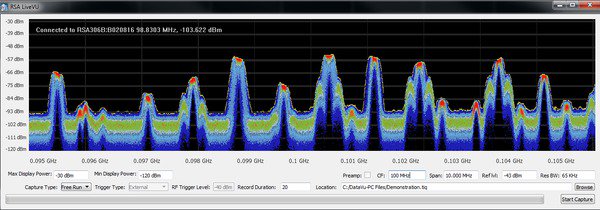
RSA LiveVu enables control of and recording with Tektronix USB-based spectrum analyzers. In the illustration above, a 10 MHz span in the FM radio band is monitored. You can set frequency, span, reference level and preamplifier state, and you can create IQ waveform recordings at the push of a button, or when an internal or external trigger is received by the instrument(s). Recording bandwidths from 9.7 kHz to 40 MHz are available, allowing you to greatly reduce the data load of the recording. Control of and recording with a single instrument is included in the DVPC-SPAN licenses for SignalVu-PC.
DVPC-MREC enables live control and recording with two USB-based spectrum analyzers
| Features and Functions | Description |
|---|---|
| DVPC-MREC Application License (requires any DVPC-SPAN license and DVPC-SMARK license | Ability to operate and record from two Tektronix RSA300/500/600 series spectrum analyzers simultaneously |

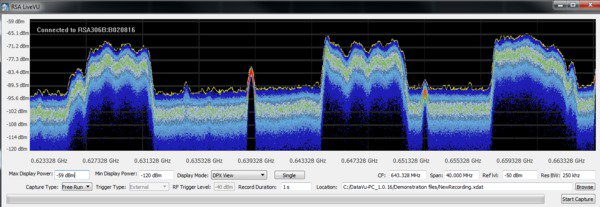
Be two places at once with the DVPC-MREC application, enabling independent control of two instruments. You can record widely-separated transmit/receive bands, or any two areas of interest with this capability. You can set one analyzer to sweep a broad span (up to the full range of the instrument), and then direct the second analyzer to tune to areas of interest found with the broad sweep. In the illustration above, a wide 9 kHz-1 GHz sweep is running in instrument one, and a 40 MHz span from that sweep is shown in the DPX real-time display from the second instrument. Recordings can be made from 9.7 kHz span up to 40 MHz on either or both instruments.
Measurements enabled with application license DVPC-SMARK
DVPC-SMARK enables the smart markers in DataVu-PC, with user-defined amplitude search and mark, frequency-mask search, and enables the Time Overview display. Requires a DVPC-SPAN application license. Capabilities are shown in the table below.
| Features and Functions | Description |
|---|---|
| DVPC-SMARK application license (requires any SPAN application license) | Ability to search or tag an unlimited number of markers in a file Save up to 2,000,000 markers in PDW or JavaScript Object Notation (JSON) format Adds Power Threshold sSearch, eMarker View and Time Overview features to any base version of DataVu-PC |
| eMarker Functions | Manually add a marker on mouse click or in table Add user comments on each marker Make delta marker measurements Define file start-stop time to be between any two markers Store and recall saved markers in PDW format Load existing marker or event trigger files from previous analysis in .xmark or .emark formats Delete individual or all markers |
| eMarker Visualizations | Visually display all markers on progress bar Provides nested marker display for files with up to 2,000,000 markers View all markers in eMarker list display |
| Power Threshold Search | Power Threshold: Minimum power amplitude a signal must exceed to be discovered as a marker Set Minimum Sample Dropout: Ignore dropouts less than user-defined number of samples in length Set Minimum Pulse Sample Duration: Ignore pulses less than user-defined number of samples in length Moving Average Filter: Determines number of filter points to use in search |
| Frequency Mask Search | Frequency Mask Search will mark each violation of a user-defined frequency mask present in the recorded waveform. Users can define hundreds of points in frequency and amplitude, or the search can auto-draw a search mask based on the on-screen waveform |
| Time Overview Display | Time Overview displays the entire recording in a single view. You can zoom on areas of interest. The zoomed in area sets the start/stop points for detailed analysis in the spectrum, spectrogram and power vs. time displays |
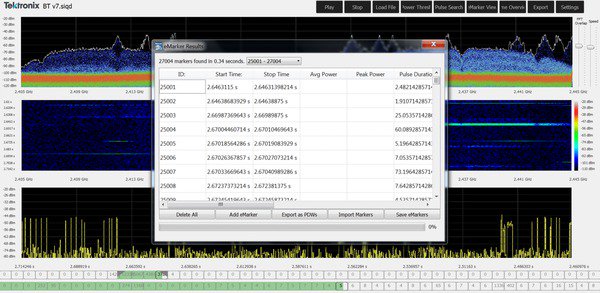
eMarkers allow you to find all possible markers that match your desired criteria and save up to 2,000,000 points of interest in a file. In the illustration above, the power threshold search has been used to find signals of interest and place them in the emarker list view. The marker points are also indicated as vertical grey lines on the green progress bar at the bottom of the screen. Up to three nested progress bars can be displayed for greater marker resolution in the file. Marker points can be used to define the re-analysis point for the recording, allowing you to quickly zoom in on the signal of interest for deeper examination.
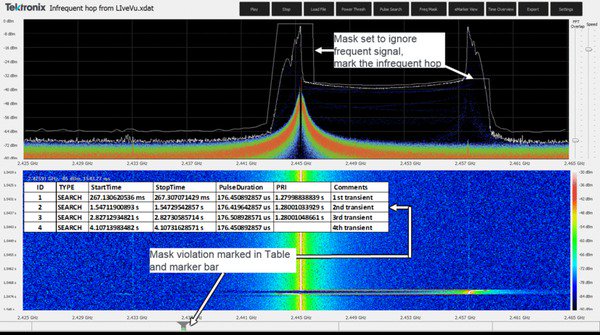
The frequency mask search can quickly find spectrum violations and signals lower than the dominant signals in the recording based on both amplitude and frequency characteristics. In the illustration above, a mask has been created for just the signal of interest (on the right), so that markers will only be placed on the infrequent violations in the file. The equal-amplitude signal to the left of the signal of interest is ignored during the search. Four violations were found in the search, indicated in the results table. You can immediately determine the repetition rate and duration of each transient, and make notes in the table on the nature of each violation. The progress bar at the bottom of the screen shows a mark at each violation time in the file, and the spectrogram has been set to display the second violation.
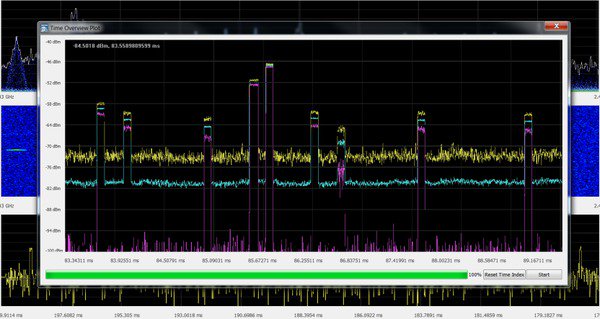
The Time Overview display in application license SMARK provides the +peak (yellow), -peak (purple) and average (blue) traces of the entire recording in a single snapshot. You can use the mouse to identify an area of interest, and this portion of the time record is used to set the start and stop points of the detailed analysis. In this way, you can easily zoom in on active regions, quickly examing areas of interest.
Measurements enabled with application license DVPC-PULSE
DVPC-PULSE enables search and marker measurements. Up to 2 million pulses can later be stored for reanalysis in PDW and JSON format. Requires DVPC-SPAN and DVPC-SMARK application licenses. Functions and features of DVPC-PULSE are shown below.
| Features and functions | Description |
|---|---|
| DVPC-PULSE Application License (requires DVPC-SPAN and DVPC-SMARK licenses) | Adds pulse measurements |
| Pulse Measurements | Results for start/stop times, pulse average power, peak power, pulse duration, PRI, pulse start/stop frequencies Save up to 2,000,000 pulse results as eMarkers and view them in a list Export pulse measurements in .PDW |
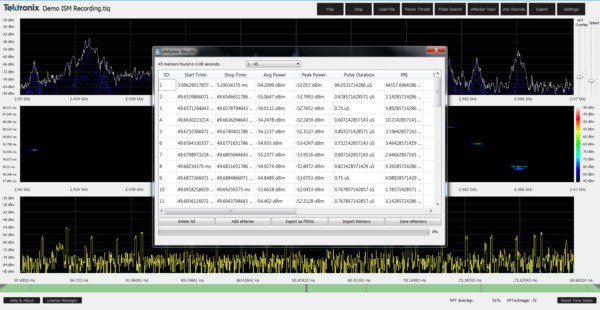
The pulse analysis application license illustrated above enables you to search for pulses and return all results with start/stop time, average power, peak power, pulse duration, PRI and start/stop frequencies. Pulse parameters can be exported to a CSV file for use with other tools.
Minimum requirements
PC Windows 7, 8 or 10 (64-bit) with minimum 1 GB RAM, 400 MB drive space, and internet connection for software activation and playback functions. Operation of RSA LiveVu recording features requires a PC capable of streaming 2-USB 3.0 ports each at 300 MBytes/second. Each USB 3.0 port must support the 5 Volt, 1 Amp USB 3.0 standard. Recording at 40 MHz bandwidth requires a drive capable of streaming storage at 300 MBytes/second. Recording two simultaneous 40 MHz bandwidth streams requires a drive.
Licensing information
DataVu-PC uses the Tektronix Asset Management System (AMS) for licensing your applications. Two types of licenses (Node-locked and Floating) are available.
License types
Node-locked license: Can be associated with, and re-associated to, a different PC 2 times.
Floating license: Can be associated with a PC and can be re-associated to different PCs an unlimited number of times.
Free version and Trial license available
The free version of DataVu-PC gives you limited functionality to view any supported recording for a short duration (100 milliseconds). A recording of Bluetooth, WLAN, and microwave oven signals is included with the software for your evaluation. A trial license that unlocks all capabilities of DataVu-PC is available at www.tek.com/slam/catalog/trials. You will need the Host-ID of your computer to obtain the trail license. Your Host-ID can be found by opening the free version of DataVu-PC, and selecting the license manager button near the bottom left of the screen.
Functions available in the free download version of DataVu-PC
The free download includes a recorded file with the software. The file contains Bluetooth, WLAN and microwave oven signals. You can open the file and view the content utilizing any of the following three displays: spectrum, spectrogram and/or power vs. time. Basic controls for the three displays are available. The free version includes file conversion of all supported file types for any length. Full functionality for all application licenses can be activated with a 30-day trial license, available at www.tek.com/slam/catalog/trials.
| Features (Free Version) | Description |
|---|---|
| File Types Supported For Playback | .XDAT, .TIQ and .SIQD files at all bandwidths. Maximum playback length: 100 milliseconds |
| File Conversions Supported | R3F to .SIQD or .TIQ. 12-bit .XDAT to 16-bit .XDAT All supported file types for playback |
| Playback functionality | Fixed FFT overlap and speed controls. Ability to play back a recorded file using any of the available displays: spectrum, spectrogram and/or power vs. time. Controls for persistence spectrum decay, max hold trace, continuous playback, windows, and power scale adjustments |
DataVu-PC ordering information
DataVu-PC is distributed via www.tek.com. Hard copy versions of the software are not available. An operation manual is distributed in .pdf format with the software.
When purchasing DataVu-PC, you choose any one of the three base version DVPC-SPAN licenses (50 MHz, 200 MHz or 1000 MHz). The only difference between span licenses is the bandwidth of the allowed analysis. Choose the bandwidth that covers the maximum bandwidth of your acquisition/recording system. For example, all USB-based analyzers are accommodated with the DVPC-SPAN50 license, and all RSA7100B recordings at full bandwidth require DVPC-SPAN1000.
DVPC-SMARK, DVPC-MREC, and DVPC-PULSE work with any DVPC-SPAN bandwidth license chosen for analysis. The DVPC-SMARK license requires a DVPC-SPAN license of any bandwidth, and the DVPC-MREC and DVPC-PULSE licenses require a DVPC-SMARK license.
Nomenclature | License type | Description |
|---|---|---|
| DVPC-SPAN50NL | Node locked | Base version, DataVu-PC operation on acquisitions to 50 MHz bandwidth, plus LiveVu operation of one USB instrument |
| DVPC-SPAN50FL | Floating | |
| DVPC-SPAN200NL 1 | Node locked | Base version, DataVu-PC operation on acquisitions to 200 MHz bandwidth, plus LiveVu operation of one USB instrument |
| DVPC-SPAN200FL | Floating | |
| DVPC-SPAN1000NL | Node locked | Base version, DataVu-PC operation on acquisitions to 1000 MHz bandwidth, plus LiveVu operation of one USB instrument |
| DVPC-SPAN1000FL | Floating | |
| DVPC-SMARKNL | Node locked | DataVu-PC Smart Markers, Time Overview, and Frequency Mask Search (requires base version) |
| DVPC-SMARKFL | Floating | |
| DVPC-MRECNL | Node locked | Multi-unit recording for USB spectrum analyzers (requires DVPC-SMARK) |
| DVPC-MRECFL | Floating | |
| DVPC-PULSENL | Node locked | DataVu-PC pulse analysis (requires DVPC-SMARK) |
| DVPC-PULSEFL | Floating |
1If you have a data source that operates at 50 MHz to 200 MHz bandwidth, such as a Tektronix RSA5000 or RSA6000 series spectrum analyzer with a third-party recording solution, choose DVPC-SPAN200.
Recommended products:
DataVu-PC operates on recordings using all of the instruments listed below. DataVu-PC can create recordings on all USB-based instruments listed below (RSA300/500/600 series).In addition, recordings made with the RSA5000A/B and RSA6000A/B series using third-party recorders in .XDAT or .TIQ waveform formats can also be analyzed.
| Instrument | Description |
|---|---|
| RSA306, RSA306B | USB-based portable spectrum analyzers |
| RSA500 series | USB-based portable, ruggedized, battery operated spectrum analyzers |
| RSA600 series | USB-based laboratory spectrum analyzers |
| RSA6100, RSA5100 series | High performance laboratory spectrum analyzers with IQ output, compatible with 3rd-party recording solutions |
| RSA7100B | Spectrum Analyzer, 16 kHz-26.5 GHz, up to 800 MHz acquisition bandwidth, laboratory form factor with available streaming option in SignalVu-PC |





